In the far reaches of the globe, where isolation meets extreme conditions, there exist communities that defy the conventional notion of connectivity. These are places where daily life unfolds against the backdrop of unparalleled remoteness, challenging the resilience of the individuals who call these corners of the world home. From frozen landscapes in the Arctic to distant islands in the Southern Hemisphere, the following list explores the 10 most remote communities, where geographic seclusion defines their way of life. Join us on a journey to these isolated enclaves, where the pursuit of existence is marked by a unique blend of self-sufficiency, adaptation, and a deep connection to the land.
The List of the 10 Most Remote Communities in the World
1. Tristan Da Cunha, South Atlantic Ocean

The title of the most remote inhabited point on Earth goes to Tristan Da Cunha, a volcanic island nestled in the South Atlantic Ocean. Part of a five-island archipelago that shares its name, Tristan Da Cunha sits at a distance of 1,750 miles from Cape Town, South Africa, encompassing a modest 38 square miles of land.
The primary settlement on the island is Edinburgh of the Seven Seas, home to a population of 241 permanent residents as of 2022—all British citizens, given the island’s status as a British Overseas Territory. Notably, landownership is communal, with restrictions preventing outsiders from acquiring property. The local economy revolves around subsistence farming and fishing, stamp sales, and a modest tourism industry.
Lacking an airport, the sole means of reaching Tristan Da Cunha is by a six-day boat journey from South Africa, as fishing vessels make the trip eight or nine times a year. This isolated island stands as a testament to human resilience in a uniquely challenging geographical setting.
2. Pitcairn Islands, Southern Pacific Ocean
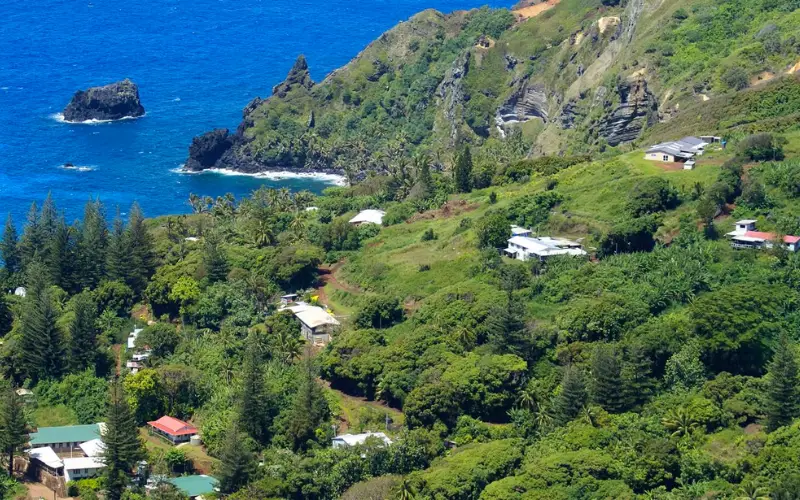
The Pitcairn Islands, constituting a cluster of four volcanic landmasses in the Southern Pacific Ocean, fall under the purview of the British Overseas Territories. Of these islands, only Pitcairn Island, a compact two-square-mile territory, is inhabited. The island’s population is uniquely traced back to the mutineers of HMAV (Her Majesty’s Armed Vessel) Bounty and their Tahitian companions, as noted on the government website.
Following an abuse scandal in 2004, which led to the imprisonment of the mayor and five other men, Pitcairn Island experienced a decline in population. In an effort to revive the community, the government initiated a program offering free land. According to the Pitcairn Island Economic Review, the population in 2013 stood at 49.
Despite facing challenges, including a temporary closure due to the COVID-19 pandemic, Pitcairn Island reopened for tourism at the end of March 2022. Travel options include freighter ships departing from New Zealand or adhering to the usual sailing schedule. The island’s unique history and reopening signify both its resilience and the government’s endeavors to foster growth and sustainability in this remote community.
3. Easter Island, Chile
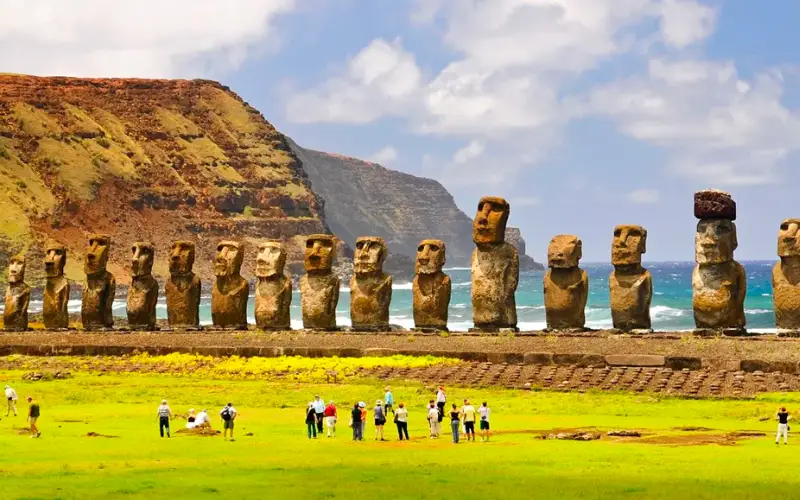
Easter Island, or Rapa Nui, falls within the jurisdiction of Chile despite its remote location approximately 2,200 miles off the coast. Positioned over 2,600 miles from Tahiti, a common departure point for tourists, and significant distances from Pitcairn Island and the largest Gambier Island, Mangareva, Easter Island is renowned for its 887 monolithic statues, the moai, carved by the indigenous Rapa Nui people between 1250 and 1500 C.E. Designated as a UNESCO World Heritage site, the island is home to fewer than 8,000 permanent residents.
Remarkably, this isolated island holds the distinction of being the closest landmass to the oceanic pole of inaccessibility, also known as Point Nemo. Positioned in the ocean at 48°52.6′S 123°23.6′W, Point Nemo is recognized as the farthest point from any land. Situated over 1,000 miles away from the coasts of Easter Island, Ducie Island (within the Pitcairn Islands), and Maher Island off the coast of Antarctica, Easter Island stands as a captivating testament to both ancient cultural heritage and geographical uniqueness.
4. Devon Island, Canada
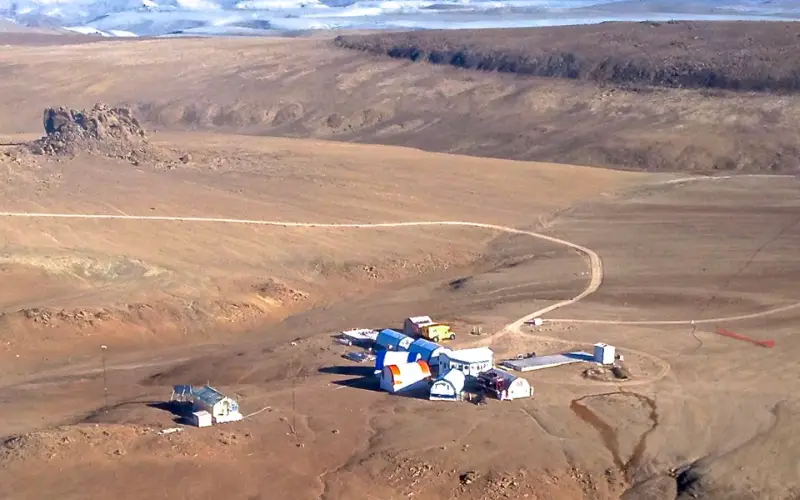
Devon Island, referred to as Tallurutit in Inuktitut, stands as the largest uninhabited island globally within Canada’s Nunavut Territory. Its harsh, cold, and rocky landscape has served as a surrogate Mars environment for scientists over the past two decades. The seasonal simulation expeditions, focused on Devon Island’s Haughton, a 12.5-mile-wide meteorite impact crater dating back 23 million years, provide an otherworldly setting for NASA’s testing of robots, spacesuits, drills, and various space tools since the 1990s.
Although not as distant as Easter Island, Devon Island places you in relative isolation from the nearest civilization, with Cornwallis Island, inhabited by around 200 people, located 50 miles away. The island’s extreme conditions make it a unique and valuable location for space-related research and testing.
5. Kerguelen Islands, Southern Indian Ocean

Positioned over 2,000 miles from civilization, the Kerguelen Islands in the southern Indian Ocean earn the moniker “Desolation Islands” owing to their exceptionally remote setting. Grande Terre, the largest island within this volcanic archipelago, comprises part of a French territory encompassing 300 islands, collectively spanning an area roughly equivalent to Delaware.
Devoid of native inhabitants, the Kerguelen Islands host a small community of scientists, numbering around 50 in winter and expanding to 100 during the summer, based in the sole settlement, Port-aux-Français. These researchers delve into the extensively glaciated terrain, featuring active glaciers and peaks reaching nearly 6,500 feet in elevation. Accessible solely by ship, with departures occurring merely four times a year, the Kerguelen Islands stand as a challenging yet intriguing destination for scientific study and exploration.
6. Ittoqqortoormiit, Greenland

Frozen for nine months annually, Ittoqqortoormiit is nestled between Greenland’s National Park, the largest in the world spanning approximately 604,000 square miles, and Scoresby Sound, Earth’s largest fjord covering an expansive 23,600 square miles.
Among the estimated 56,000 inhabitants of Greenland in 2021, a mere 450 people call this diminutive and secluded settlement home. Distinguished by vibrant, rainbow-hued houses set against a backdrop of mountains and glaciers, Ittoqqortoormiit finds itself encompassed by approximately 600 miles of uninhabited land on all sides.
Renowned for its rich biodiversity, the region teems with wildlife and marine life, featuring polar bears, seals, muskoxen, halibut, and whales. In this remote locale, a local pub opens its doors once a week, offering a unique social space for the 450 residents. Navigating the isolated surroundings, inhabitants rely on helicopter transport to and from the nearest airport, with the possibility of boat travel during warmer seasons.
7. Oymyakon, Russia
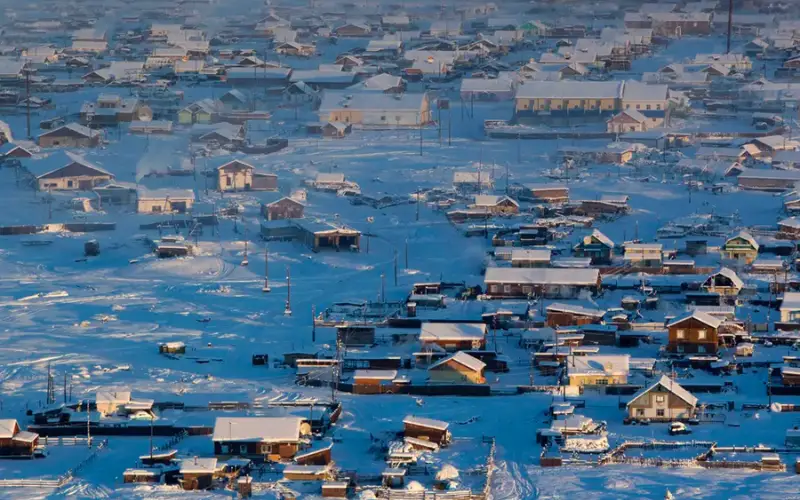
Oymyakon, Russia, finds itself closer to the Arctic Circle than to the nearest major city, Yakutsk, situated 576 miles away. In this Siberian outpost, approximately 500 resilient individuals endure the harsh conditions that have earned Oymyakon the distinction of being the coldest inhabited place on Earth, with a record low temperature of minus 90 degrees Fahrenheit recorded on February 6, 1933.
The extreme northern location results in a winter sky enveloped in darkness for 21 hours each day, while in the summer, the sun graces the town with only three hours of daylight. The hostile climate poses a challenge for air travel, with planes unable to land during the winter, rendering the town a two-day drive from the nearest major city.
Despite the formidable conditions, locals employ survival strategies, including a diet rich in reindeer and horse milk, known for their micronutrients, as well as ox meat, providing the necessary calories to combat the elements.
8. The Changtang, Tibet

This elevated expanse, known as the “Roof of the World,” is none other than the Changtang, situated on the Tibetan Plateau, which itself rests more than 2.5 miles above sea level. Soaring approximately four miles above sea level, the Changtang stands as one of the Earth’s loftiest points.
The climate in this region is characterized by extreme cold, a consequence of its high altitude, resulting in winters reminiscent of the Arctic. Summers, albeit brief, offer warmth punctuated by sudden thunderstorms and hailstorms. The Changtang is distinguished by vast highlands and expansive lakes, providing a thriving habitat for abundant wildlife, as reported by the Wildlife Conservation Society.
Home to a few hundred thousand nomads known as Changpa, the Changtang shares its territory with a diverse array of fauna, including chiru, snow leopards, kiang, brown bears, black-necked cranes, and wild yaks. The majority of this area falls under the protective umbrella of the Changtang Nature Reserve, ranking as the second-largest in the world.
9. Amundsen–Scott South Pole Station, Antarctica
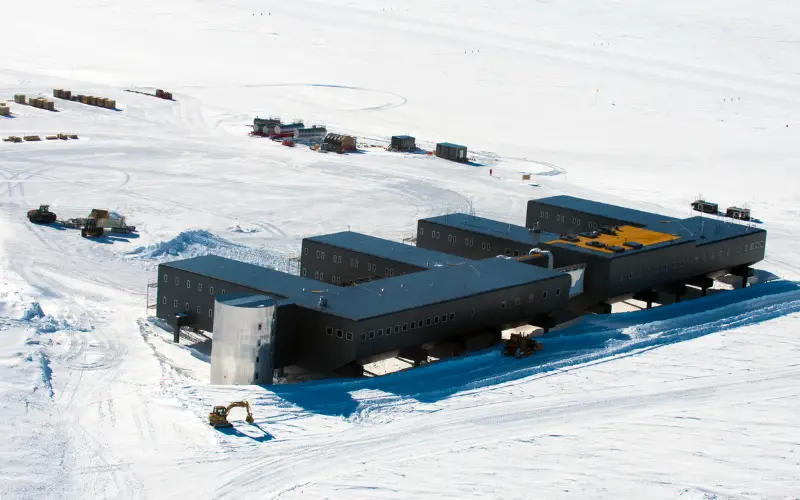
Perched at an elevation of 9,000 feet above sea level on a mobile ice sheet, the Amundsen-Scott South Pole Station in Antarctica stands 850 nautical miles south of McMurdo Station.
Experiencing a solitary day and night each year, each enduring for six consecutive months, the South Pole emerges as an extraordinary location. With temperatures plummeting to as low as minus 90 degrees Fahrenheit, it ranks among the coldest spots on Earth.
While not a residential area, it doesn’t vie with Oymyakon, Russia, for the title of the coldest inhabited place. Nevertheless, since its construction in November 1956, the station has been continuously manned by a fluctuating population of 50 to 200 American researchers.
10. Villa Las Estrellas, Antarctica
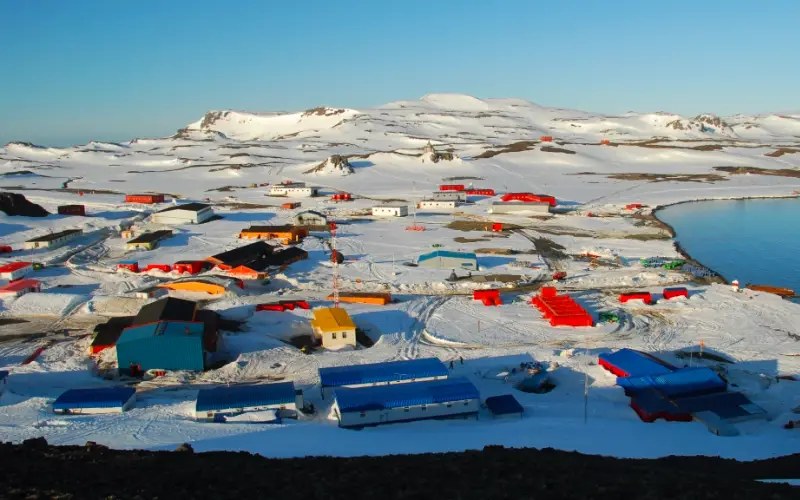
Nestled on King George Island, approximately 75 miles off the Antarctic coast and nearly 2,000 miles from southern Chile, Villa Las Estrellas stands as a Chilean village and research station with a population of fewer than 200 residents. The remote nature of this locale is underscored by the fact that those who choose to reside here must undergo an appendectomy beforehand, given the absence of a major hospital within 600 miles, according to the BBC.
Established in 1984, Villa Las Estrellas boasts a modest community encompassing 14 residences, a branch of the Bank of Credit, a public school with just a handful of students, a post office, gymnasium, hostel, and souvenir shop. The majority of inhabitants are either scientists or members of the Chilean military.
Regrettably, the presence of dogs is prohibited to prevent the introduction of canine diseases to the delicate Antarctic wildlife. Residents, however, find solace in encountering charming Adélie penguins and elephant seals in their surroundings.
Conclusion
In traversing the landscapes of the 10 most remote communities across the globe, we’ve embarked on a journey that transcends the ordinary boundaries of human habitation. These isolated enclaves, scattered across icy tundras, arid deserts, and distant islands, underscore the indomitable spirit of those who choose to reside in the extremities of our planet. The resilience, resourcefulness, and rich cultural tapestry woven into the fabric of these remote communities serve as a testament to the remarkable diversity of human adaptability. As we conclude our exploration, we are left with a profound appreciation for the tenacity of individuals who have crafted unique ways of life in the face of geographical seclusion, reminding us that, even in the most remote corners of the world, communities thrive with an enduring connection to their surroundings.
Recent Posts
Science Trivia - Astronomy ...
Step into a realm of nostalgia as we embark on a journey through the annals of pop culture and bid farewell to 35 recently obsolete technologies. In the ever-evolving landscape of innovation, certain...
